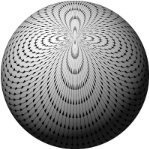

uncool
Senior Members-
Posts
1331 -
Joined
-
Last visited
-
Days Won
4
uncool last won the day on September 29 2022
uncool had the most liked content!
Retained
- Atom
Recent Profile Visitors
The recent visitors block is disabled and is not being shown to other users.
uncool's Achievements

Organism (8/13)
250
Reputation
-

Polynomials and Irreducibility exercises
uncool replied to Genady's topic in Linear Algebra and Group Theory
At the time, I didn't know what the polynomials were; the method I used told me the total number of degree-5 irreducible polynomials (6), not what they were. However, some basic manipulation gives me: [math]x^5 + x^4 + x^3 + x + 1, x^5 + x^3 + x^2 + x + 1, x^5 + x^4 + x^3 + x^2 + 1[/math] -

Polynomials and Irreducibility exercises
uncool replied to Genady's topic in Linear Algebra and Group Theory
There are a couple ways to check that may be beyond your current level; how much background do you have? Based on those ways, I'm pretty sure you've missed 3 irreducible degree-5 polynomials. -
that's...not how it works at all
-
It doesn't need to be a solid; the "solid sphere" version of the theorem is proven based on the "hollow sphere" version of it, as shown in the Wiki page:
-
Calabi-Yau manifolds are Kahler manifolds. Kahler manifolds are symplectic manifolds. Symplectic manifolds are always even-dimensional. So no.
-
Sure. Instead of saying "the product of 1+2i and 2+5i is -8 + 9i", you could instead say "the product of (1, 2) and (2, 5) under the operation (a, b)*(c, d) = (ac - bd, ad - bc) is (-8, 9)". Yes, it's a trivial renaming of the complex numbers; that's part of my point. OK, here are two real operators (as I understand it; I never received an answer as to what you meant) that fail to commute: 0 1 0 0 0 0 1 0 Possibly more relevant to QM, here are some real operators that act like the spin operators, if I haven't made a stupid mistake: 0 0 1 0 0 0 0 1 1 0 0 0 0 1 0 0 0 0 0 1 0 0 -1 0 0 -1 0 0 1 0 0 0 1 0 0 0 0 1 0 0 0 0 -1 0 0 0 0 -1 where multiplication by i is replaced by multiplication by the matrix 0 -1 0 0 1 0 0 0 0 0 0 -1 0 0 1 0 All of the components of each operator are now real. Yes I am aware of extension algebras and arithmetic and I know tha there are some pretty exotic creations floating around there, but I am not very adept at them. I was always given to understand that for every gain in one direction you tend to loose something in another when you add to algebraic complexity. You seem to have quoted yourself; I'm not sure I see how this responds to my post.
-
I'd need you to first define "real operators". As I said earlier, anything that can be defined in terms of complex numbers can instead be defined in terms of pairs of real numbers, etc. I meant that I have no idea what connection you are trying to draw between unique factorization and quantum physics. Why not? Why should √5 be considered "integer", while (1+√5)/2 can't be? How are you defining "integer" outside of the actual integers? It turns out that (1+√5)/2 actually is quite integer-like, in that it can solve monic polynomials; such numbers are actually called "algebraic integers", and act somewhat like integers do for rational numbers.
-
Err, what? Complex numbers are entirely commutative, and any way in which noncommutativity appears in QM can appear in a "real" explanation just as much as for a "complex" one. Um. Two things. First, there are plenty of subrings of the real numbers that fail to satisfy unique factorization. Consider Z[√5], and factor 4. That can be fixed in a somewhat natural way by adding (1+√5)/2; however, the "natural" fix doesn't work for Z[√7] (and this failure - among others - is a reason for the modern study of algebraic number theory, especially ideal class groups). Failure of unique factorization is not inherently related to complexity. Second, I see no reason why a failure of unique factorization is "essentially a quantum behavior".
-
Strictly speaking, no, you do not "need" the complex numbers for anything. You can write everything you do in term of pairs of complex numbers, which just so happen to have the properties of the complex numbers. You could go even further; real numbers are equivalence classes of sequences of rational numbers (under an equivalence relation of, approximately, "limits to the same number"). And further still; rational numbers are equivalence classes of pairs of integers (under an equivalence relation of "same ratio"). And yet further; integers are equivalence classes of pairs of rational numbers (under an equivalence relation of "same difference"). But it's far more convenient to not constantly be going through this entire hierarchy to make even simple statements. It's much, much easier to simply define a set of numbers once, and then deal with all of the ramifications by repeatedly using that definition. And the complex numbers turn out to be useful enough to do so - much more than you might expect, in fact.
-
Funny enough, for Catholics it apparently doesn't necessarily have to be pure for the purposes of baptism. https://christianity.stackexchange.com/questions/65635/how-much-can-holy-water-be-diluted
-

"Disproving" Cantor's hypothesis -- it's trivial, anyway
uncool replied to NTuft's topic in Speculations
No. They are, in fact, in bijection, and both are in bijection with the set of all real numbers, and both are in bijection with the set of all complex numbers. Again, what is your point? Again: there is nothing inherently uncountable about individual transcendental numbers. You keep bringing up that some of these numbers are transcendental as if that, by itself, implies uncountability. It does not. First: what is your argument for uncountability? Second: that set is very clearly countable. It is very clearly the image of a countable set, namely the set of pairs (x, y) where x and y are both in i', under the map of exponentiation. Once again: emphasizing that you are getting results which are transcendental numbers does not tell you anything about whether the output you get is uncountable. At the absolute best, it removes a single, overly-simplistic proof of countability; that does not constitute a proof of uncountability. -

How did the concept of quantum entanglement arise?
uncool replied to geordief's topic in Quantum Theory
It was almost certainly the tensor product. The statement "these two particles are entangled" is, more formally, "the combined state of these two particles is not a pure tensor element in the tensor product of the state spaces of each element separately". While I don't know the history itself, entanglement itself is a rather natural aspect of the fact that quantum physics is fundamentally linear, and that the tensor product is the "natural" way of dealing with bilinearity. -
Bit more than that; don't forget the inner product. I'd say that that's the central aspect of Hilbert spaces. Depends on what you mean by "aspect" or "attribute"; I'd also be careful about what you mean when you say "something like its own dimension". If you mean that each particle (and simplifying to quantum mechanics, where there is no particle creation or annihilation), then kind-of, but not really. To explain further, and in some formality: the state space for a combination of particles comes from the (completion of the) tensor product of the state spaces of the individual particles, not a direct sum. Sorry, but I don't really have a less technical explanation for what that means. I'd say that each eigenstate a QM "entity" can be in can be thought of somewhat separately, yes (until you get some time evolution that mixes between eigenstates). To my recollection (which is admittedly rusty), the use of "state" can be somewhat ambiguous; it can either be used to mean a single eigenstate (of an unspecified operator), or can mean an arbitrary mixture. In the latter case, I'd say that the answer to your question is "no"; for example, the the states |a>, (3/5) |a> + (4/5) |b>, and |b> cannot really be thought of as in "different dimensions".
-
On what level do you want an answer? Because on one level, it was a bunch of wars and abolition movements. But that doesn't answer how all those wars and abolition movements came together. On another, it was a bunch of philosophical movements that led to ideas of liberty. But that doesn't answer why those movements came to the forefront. On another, it was a result of economic forces giving rise to systems that outcompeted slavery. But that doesn't answer why they hadn't happened earlier. And so on and so forth.
-
Yes, that makes sense; I had read your statement as "So he could determine in principle that Alice has performed a measurement [instantly], but he wouldn't be able to tell which outcome Alice got until he made the measurement", because the second half of the statement was qualified by timing while the first half was unqualified. Sorry about that.


